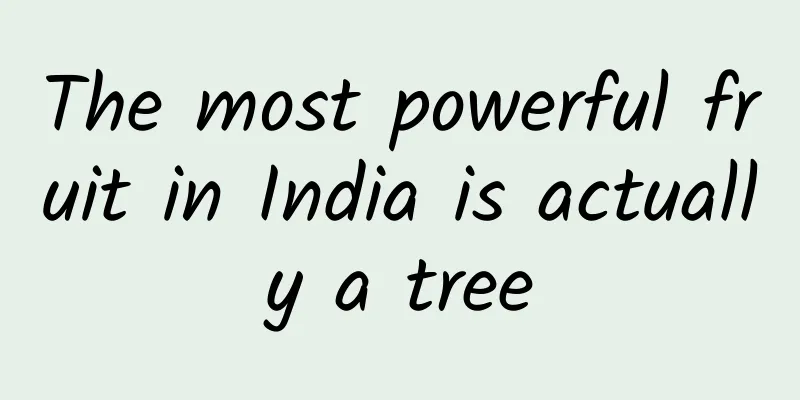|
Walking in the cattle-ridden streets of India, you can easily see a group of dark-skinned locals in white shirts sitting in front of a street stall chewing on tree trunks. But this has nothing to do with poverty and disaster. This tree trunk is probably the strongest fruit in India and is believed to hold the secret of fertility.
Civilizations are always learning from each other. Buddhism traveled across the ocean from India and became a part of Chinese civilization. The concept of "like cures like" in traditional Chinese medicine also had a place in Sakyamuni's hometown. It is impossible to verify when and why this tree trunk, which is regarded as a fruit, was regarded as a tonic by the Indians. But its appearance is one of the key factors that made it a deity.
Although the fruit tree trunk looks like a yam with growth hormone imbalance, it tastes more like a sweet potato. It has a fine texture, is refreshing and delicious. People are particularly in demand for it in summer. It is said that some people also use it as a pillow. The fragrance emitted by the trunk and the juice oozing from the cross section can ensure that you have a vivid dream in the light sleep stage.
Indian yam is thick, strong and powerful. A devout old man used it as a beam for 30 years. After taking it down, he found that it still remained in its original shape and was as hard as steel bars. But smart eaters can always find a way to bridge desire and release. Street vendors selling tree trunks usually use a knife to slice the trunks into thin slices from the cross section before selling them, so that people don't directly put the rhizome as thick as an elephant's leg into the mouth of a city management officer whose mind is not much broader than that of a city management officer.
The vendors believe that the thinner the slices, the more they reflect their piety for fertility, and also enhance the medicinal properties of the food. Since this snack is sold by piece rather than by pound, the more pious the vendors, the deeper their wallets will be.
There are many legends about fertility surrounding the Indian yam. If you are a native Indian or have sold mobile phones there for a while, you will have heard of miracles that happened to people after eating it. A young customer once said that after eating it, he couldn't help but stand up when he saw the Ganges. Some people even said that after feeding it to cows at home, it can naturally conceive without a bull.
Among a series of stories that alternate between reality and fiction, the most famous one is an experience of Lord Rama. Rama was an ancient Indian prince and one of the incarnations of Vishnu, who was in charge of family ethics. According to legend, Rama was ostracized at work and exiled to the wasteland with his wife and cousin. In the wasteland, Rama survived hunger by eating yam, and brought back many children when he finally returned. His experience made Hindu believers realize that "yam" not only protects people's lives in times of disaster, but also allows the fire of life to continue in an environment without nutrition.
But the strange thing is that although it has been popular for hundreds and thousands of years and even written into myths, generations of eaters, including local Indian botanists, are not sure what this tree trunk is.
Even among vendors, it has several different names. Northern vendors call it Ram kand mool, Ram means Lord Rama. Southern vendors call it Bhoochakara Gadda, which is said to be related to a powerful god. Those in provincial cities generally call it Maerua oblongifolia. The degree of divergence is comparable to that of Indian languages.
In the 1980s, Indian botanists first traced the origin of this strange ingredient. However, they finally got a series of contradictory answers. They didn't even know whether it was the root or the branch of the plant.
In the 1990s, botanists seemed to have made some progress. Indian botanist Dr. Koppula Hemadri bribed vendors with money in the hope of obtaining clues from the upstream of the supply chain. A vendor told Dr. Koppula Hemadri that this was a plant that grew on the ground. However, based on his many years of experience in buying vegetables, Koppula Hemadri concluded that this yam-like crop must grow underground, and the research was once again deadlocked.
In fact, one of the main reasons why Indian "yam" remains mysterious even with modern research methods is that the stakeholders keep its source confidential.
As a vendor, if you want to buy some Indian "yams" to sell, you first need to get a referral from someone in the industry. The referrer has a lifelong responsibility for the referee. If one prospers, all prosper, if one suffers, all suffer. These rules are no different from the routines of the entrepreneurs in Sicily.
In the general business story, no supplier does not want to sell in bulk. But Indian "yam" vendors, regardless of their size, are only allowed to purchase one of these things at a time.
In order to keep it secret, the supplier and the vendor would meet at places where it was impossible to guess the origin of the "yam", such as shopping mall security passages, toilets, and railways. The supplier would also frequently change the meeting place during the pick-up process.
The only purpose of these Indian merchants who "make a lot of money and worry about nothing" is to monopolize. Just like if you ask the largest chip manufacturer in the United States about their product secrets, you will only get a volley of bullets. Locking product development secrets from the source is an effective way to ensure competitiveness in the ruthless business world. The confidentiality agreement of Indian vendors on the source of "yam" is essentially the same as the actions of American chip manufacturers and some oligarchs.
This phenomenon reminds us of "convergent evolution" in biology. Convergent evolution refers to the development of organs with the same functions by unrelated organisms to meet the needs of survival due to long-term living in the same or similar environment. For example, birds and flying insects do not belong to the same species, but because they are in similar environments, they have evolved wings to deal with problems.
Based on convergent evolution, can we infer that Indian yam vendors and technology oligarchs, who also use monopoly as the ultimate commercial means, are living in the same world? Are the so-called modern commercial civilizations, which are glittering on the outside, just a crude upgrade of the law of the alley, except for the different products? Does business actually have no technical content at all? No matter what form it takes, monopoly and price war are eternal and unique?
Back to Indian "Yam".
With the development of science and technology and the unremitting efforts of researchers, in 2011, Indian botanists found through DNA identification that the similarity between "yam" and agave was 89%. It was basically confirmed that this yam came from the root of an agave plant.
This discovery unexpectedly provided an answer to why vendors sliced the roots into thin slices. Because agave juice is highly toxic, overdose can cause blindness or even death. Slicing the roots into thin slices so that diners eat less can increase sales margins and ensure that the vendors don't have to collect the bodies of customers after consumption. peace Source: beebee planet |










